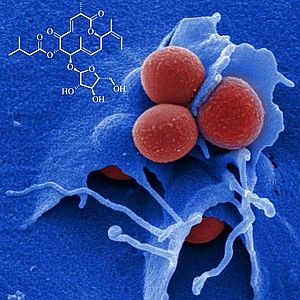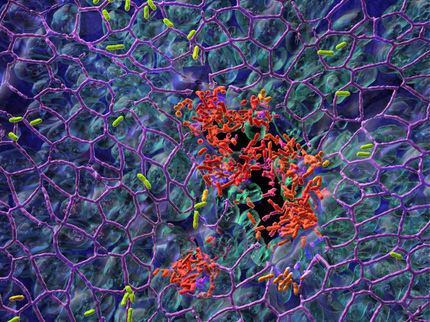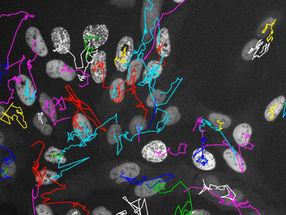New antibiotic against hospital-acquired pathogens
Scientists discover substances effective against multi-resistant pathogens
Multi-resistant staphylococci are amongst the most feared pathogens in hospitals since they respond to therapy only very little or not at all any more. Scientists of the Helmholtz Institute for Pharmaceutical Research Saarland (HIPS) and of the Helmholtz Centre for Infection Research (HZI), Braunschweig, Germany, successfully isolated two substances from soil-dwelling myxobacteria that prove to be highly effective against these pathogens. The discovery of the scientists lays the foundation for the production of new medications. The results are published in the professional journal, "Angewandte Chemie International Edition".

HZI/Rohde
Staphylococcus aureus is the most common cause of hospital-acquired infections in Germany. In humans, this pathogen can cause wound infection, respiratory tract inflammation and urinary tract infection. Since the bacterium is resistant to many antibiotics, it is also called multi-resistant or methicillin-resistant Staphylococcus aureus – or MRSA for short. Since these pathogens are hardly or not at all susceptible to therapy with existing medications, new active substances need to be found to control these hazardous pathogens. "But it is not all that easy to find new antibiotics, since these have to have a number of special properties", says Prof Rolf Müller, Executive Director of the HIPS.
He and his colleagues from the "Microbial agents" department at the HZI just detected a new basic structure in a myxobacterium that proves to be highly effective against multi-resistant pathogens. "We were able to show that disciformycin A and B are highly active against otherwise resistant staphylococci and other pathogens. We also showed that there is no cross-reactivity with other antibiotics we used," says Müller. "This means that they do not act like other antibiotics that are already known." The newly found antibiotic is effective against gram-positive bacteria without damaging human or animal cells. "Therefore, it has a broad therapeutic range," says Dr Markus Nett of the Leibniz Institute for Natural Product Research and Infection Biology - Hans-Knöll-Institute (HKI) in Jena, Germany, whose research group discovered a very similar substance.
There are a number of steps to be taken first before the newly found substances can be used as an antibiotic. Firstly, the production of the substances needs to be optimised in order to have sufficient quantities available. Then chemical modifications are made to the candidate agent and the pharmaceutical properties are tested.
The researchers intend to initiate these next steps jointly with their colleagues from Jena: the submission of a patent application for the substance and the further characterisation. Rolf Müller is encouraged by the fact that several researchers in Germany discovered molecules of a similar nature and research them intensively: "This shows that we are on the right track and that further development will pay off."
The researchers also attempt to find out the exact mechanism of action of the newly discovered substances. "We already made some progress in this area and there is much evidence suggesting that this is a novel mechanism of action," says Müller. "But this is still being researched intensively."
Only then studies on an animal model can follow, which are required for use as a medication. The main purpose of these studies is to find out how toxic the new substances are for the body. "Then, the molecule needs to be tested on humans in a phase I study. But this is a long way to travel and we probably need to find a pharmaceutical firm for a partner," says Müller.























































